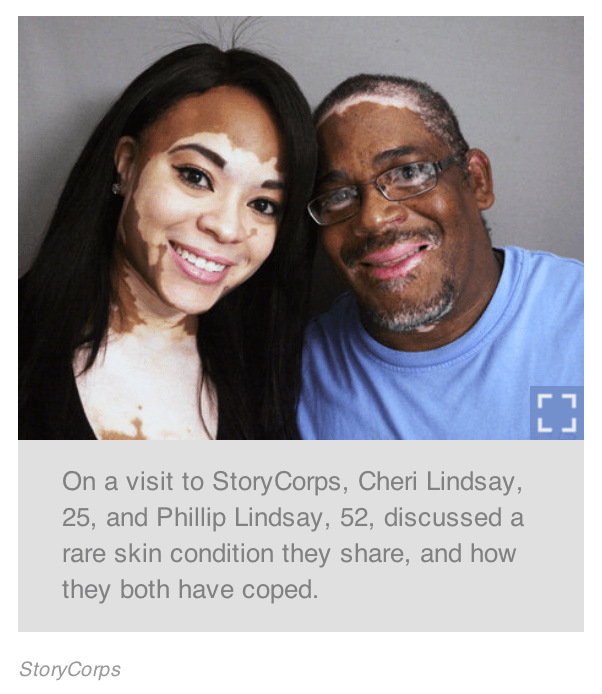
I was driving into Boston on Friday to meet with a pharmaceutical company and discuss developing new treatments for vitiligo. While I was listening to National Public Radio (NPR), I heard a human-interest piece titled, “Inheriting A Rare Skin Condition, And The Ability To Laugh About It”. It was an entry for StoryCorps, where they record stories from people in America that they archive into the Library of Congress for posterity. It’s about a father and daughter who both have vitiligo, and how that affected their relationship.
First, I had to get past the fact that they called vitiligo a “rare skin condition” – it is not. In fact, it’s one of the most common autoimmune diseases of the skin or any organ. But after that, the story reminded me of a question I’m asked in clinic by patients all the time. “What are the chances my kids are going to get vitiligo?” They know the emotional and other struggles that go along with having vitiligo, and are afraid for their children.
The risk of developing vitiligo in the general population is about 1%, or 1 in 100 people. That is really common. In comparison, the risk for juvenile diabetes is about 0.2%, or 1/500, and multiple sclerosis is 0.1%, or 1/1000. Because vitiligo is so common and visible, I see multiple people with it when I’m in large crowds, like at town fairs (a favorite past time in the fall). I often catch myself staring, and then feel terrible because that’s one of the main complaints of patients with vitiligo, and one that’s discussed in the NPR story (the daughter jokingly tells a child she caught it by staring at someone else). Both men and women are at similar risk for getting vitiligo, and over half of patients who have vitiligo got their first spots before the age of 20. We think the risk is the same all over the world, but we don’t know for sure. In fact, it’s likely even more common than 1%, because unlike patients with juvenile diabetes who must go to the doctor for treatment to survive, vitiligo patients may or may not choose to go to the doctor, and therefore may not be “counted”.
Ok, now for the risk to family members. This is particularly interesting to me, because my grandmother (on my mother’s side) and her brother both had vitiligo, but I don’t have it (yet). If a person has vitiligo, the risk that a first-degree family member (parent, child, or sibling) is 5%, or 5 times higher than the general population. That seems like a big increase, but even so, that means only about 1 in 20 first-degree relatives of vitiligo patients get vitiligo as well. That brings me back to the NPR story – the father in the story says, “I was shocked, because I had asked doctors if any of my kids would have vitiligo, and they said, ‘Probably not, it usually skips a generation.’ So when I found out that you had it, I was scared for you.” It’s not true that vitiligo “usually skips a generation”. It may seem that way though, since later generations have more people (you typically have more grandchildren than children, and so on), and therefore it’s more likely that someone will get the disease in later generations because there are just more people.
The fact that vitiligo is more common in family members of people with vitiligo means that genetics play a role in the disease. That’s not too surprising, since genetics plays a role in most diseases, as well as normal traits (like hair color, height, etc). Dr. Richard Spritz has done some amazing work in the past 10 years discovering some of the genes that affect vitiligo risk, and I’ll ask him to comment on his work in a future blog entry.
Finally, it’s important to mention that genetics aren’t the entire story for vitiligo. Environmental factors, and probably chance, each play a role as well. We know this because an identical twin of a person with vitiligo has a 23% risk of developing the disease as well, even though almost all of their DNA is identical. If genes were the whole story, that risk would be 100% (as with cystic fibrosis, for example). I’ll blog about these environmental and other factors in the future as well, but in the meantime, you can read about environmental factors here.